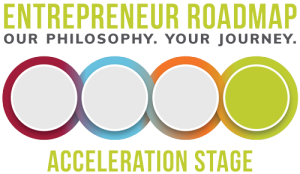When creating sales material, always answer the prospect’s question, “What’s in it for me?”

 You’ve done it—you’ve completed this crazy sprint through the Entrepreneur Roadmap Methodology to Develop a product and get it out to the masses. Your weeks and months of hustling are done, and you can now sit back and watch as the customers fly in the door. Oh, if only it worked that way.
You’ve done it—you’ve completed this crazy sprint through the Entrepreneur Roadmap Methodology to Develop a product and get it out to the masses. Your weeks and months of hustling are done, and you can now sit back and watch as the customers fly in the door. Oh, if only it worked that way.
Building a product and creating a website are just the initial steps to driving awareness and consumption. Prospects also need to be convinced that what you are providing is truly going to be a game-changer. Simply stated, they want to know, “What’s in it for me?”
The good news is there are a handful of simple components you can include that go directly at that proof, reinforcing that the product really is that good and you don’t want to miss out on it. More importantly, these assets will support your demo script, sales presentation (if you have one), and media outreach, giving you a solid basis of credibility to establish consumer awareness and engagement.
Case studies
The most effective way to convince someone to believe in your product is to show practical success. For example, if you built an app to change workout habits, then sharing a case study of how someone used that app to go from a sedentary lifestyle to running a 5K in three months is a great example of how it works. Being able to share specific details like pictures, data and results further reinforces the value of your product and establishes need.
Ideally, capturing such examples will be something you negotiate with early or pilot customers, even going so far as shaving a few dollars off the list price in exchange for use of their story, data and imagery. If at all possible, try to name the user in the case study as authenticity furthers your credibility and is more likely to prompt people to act.
Return on investment calculators
If your product has a larger price tag, you might be well served to provide a return on investment calculator. While more common in the business-to-business world, an ROI calculator allows the user to determine just how quickly they will see your product impacting their bottom line. This could be in dollars saved through labor efficiencies, better processing, optimized data costs or in revenue generated via larger sales or prospect acquisition. The fundamental goal here is to show that you can quickly impact their bottom line, further justifying the investment as a smart business decision.
Quick note: This is where understanding your prospect and their buying behavior is incredibly important. If they have to prove value on every major spend, providing an ROI calculator will be part of the cost of doing business with them. Trying to sell to them without the necessary tools they need to get to yes will limit your capacity to move them meaningfully through the funnel.
Thought leadership
While the concept of thought leadership may feel a bit fluffy, establishing yourself as the solution to their problem links directly back to your value proposition and why people should care about what you are offering. Using my example from case studies, if you built an app to change workout habits, your own track record ties back to why you have the credibility to focus in this area. Leaning on that personal background and product value proposition, as well as the information gained during validation, helps you establish credibility for your product. This provides a reason for the prospect to pay attention or believe in your claims. It also shows that there is a critical basis for why your product works or will have a positive impact on the prospect by improving their outcome. This can help you establish credibility until such time as you have case studies that directly prove how your product works and helps reinforce its value.
If you can keep these three components in mind as you think about your approach, and use them to underpin everything you do, it will be much easier for you to establish critical velocity and gain traction. Remember, if someone is going to change a behavior or take an action, they want to know what’s in it for them. Proving your product is in fact that good and that it will make a positive impact on what they are trying to accomplish (when your proof is backed up by logic) helps to nudge prospects forward to making the buy.
